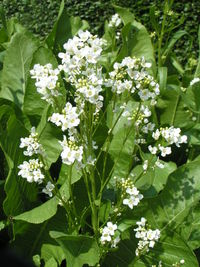
Photo from wikipedia
Abstract Drought and cold temperature as the most important abiotic factors reduce the agricultural productivity in the world. In this research, the influence of irrigation levels on biochemical changes and… Click to show full abstract
Abstract Drought and cold temperature as the most important abiotic factors reduce the agricultural productivity in the world. In this research, the influence of irrigation levels on biochemical changes and cold hardiness of two commercial Iranian pomegranate cultivars (‘Shishecap’ and ‘Malas-Yazdi’) investigated during 2016 and 2017. A factorial experiment based on randomized complete block design was used with three irrigation treatments including full irrigation (control), 75% of crop water requirement (moderate stress) and 50% of crop water requirement (severe stress). At the end of the growing season, some biochemical traits such as proline, soluble carbohydrate, starch, and total phenolic content as well as antioxidant activity and 50% lethal temperature (LT50) were measured in pomegranate stems. Proline, total phenolics, soluble carbohydrate content and antioxidant activity increased and starch content decreased with reducing the irrigation level. The most autumn cold hardiness in November for ‘Shishecap’ (−16.26 °C and −15.56 °C, respectively for the first and second year) and ‘Malas-Yazdi’ (−13.50 °C and −12.33 °C, respectively for the first and second year) was found in control trees, and the lowest cold hardiness for ‘Shishecap’ (−12.63 °C and −11.65 °C, respectively for the first and second year) and ‘Malas-Yazdi’ (−12.85 °C and −11.50 °C, respectively for the first and second year) were recorded in severe stressed plants. Winter cold hardiness in ‘Shishecap’ was affected by irrigation levels during both years; however in ‘Malas-Yazdi’, it was affected by irrigation levels only in the first year of study. Based on the Pearson correlation coefficients, starch content had a positive correlation with cold hardiness at the end of the growing season. Also, correlation coefficients between soluble carbohydrate and LT50 in November (r = 0.82, P ≤ 0.001) were negative. Therefore, it can be concluded that irrigation levels affect the pomegranate trees cold hardiness. Full irrigation resulted in an increase in the cold hardiness in the pomegranate trees, depending on cultivar.
Journal Title: Scientia Horticulturae
Year Published: 2019
Link to full text (if available)
Share on Social Media: Sign Up to like & get
recommendations!